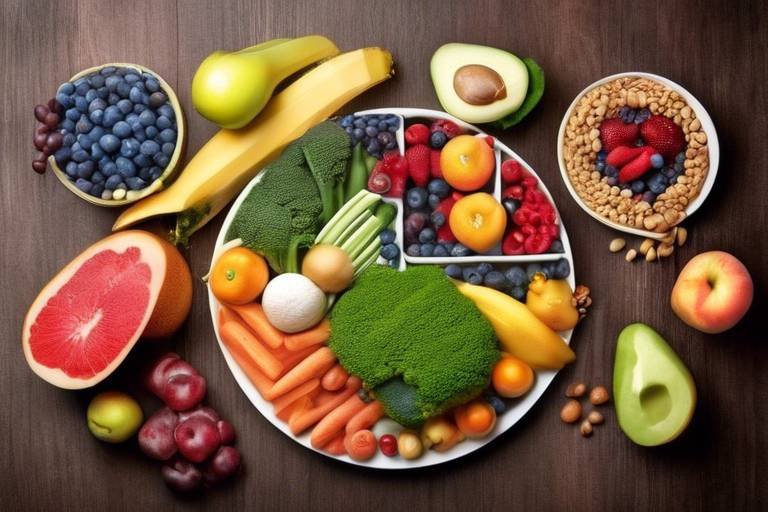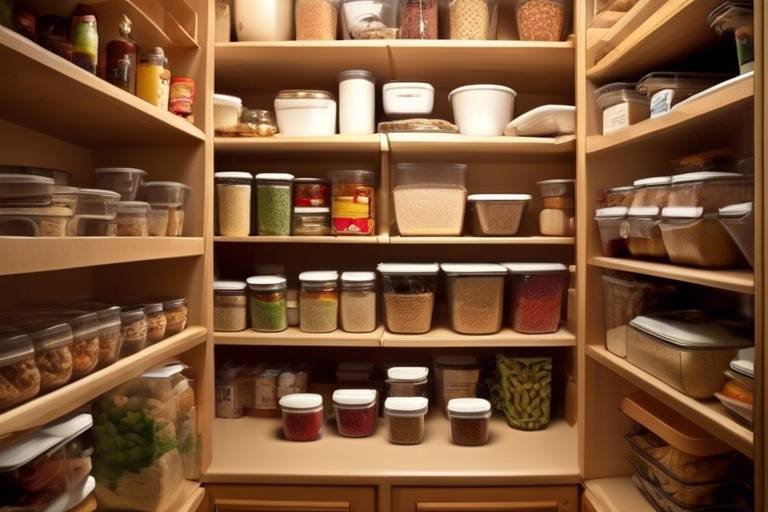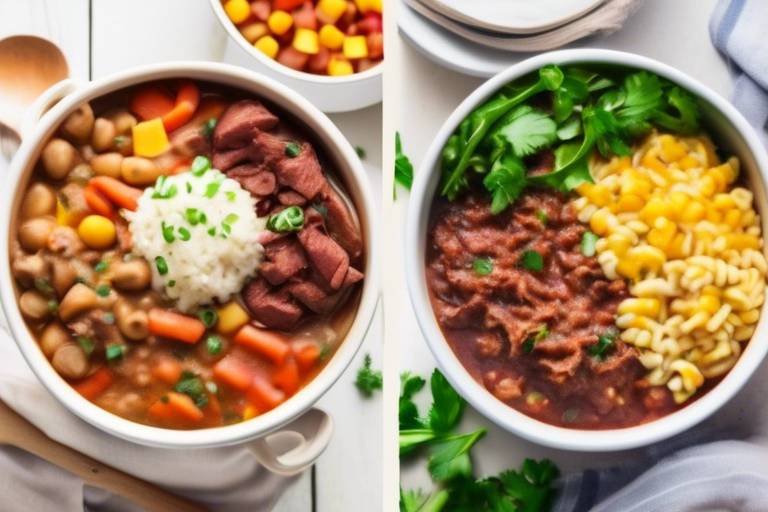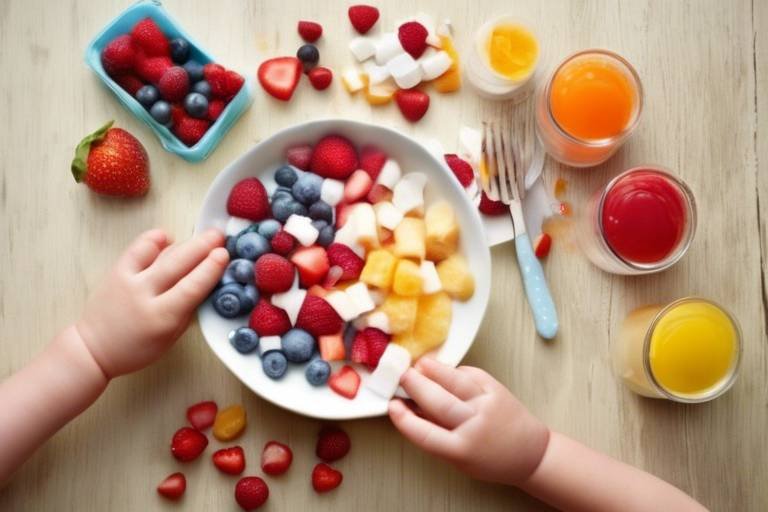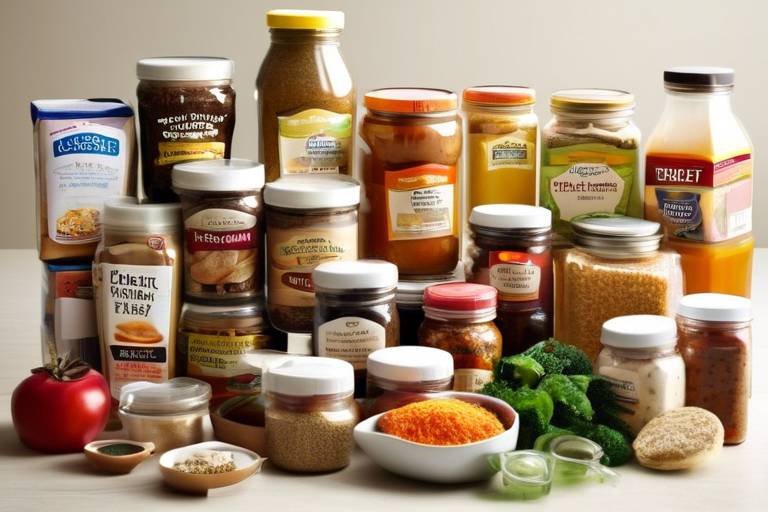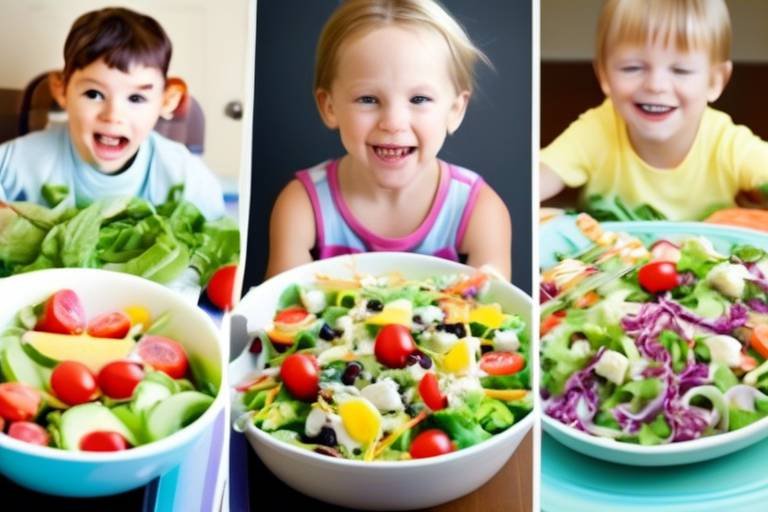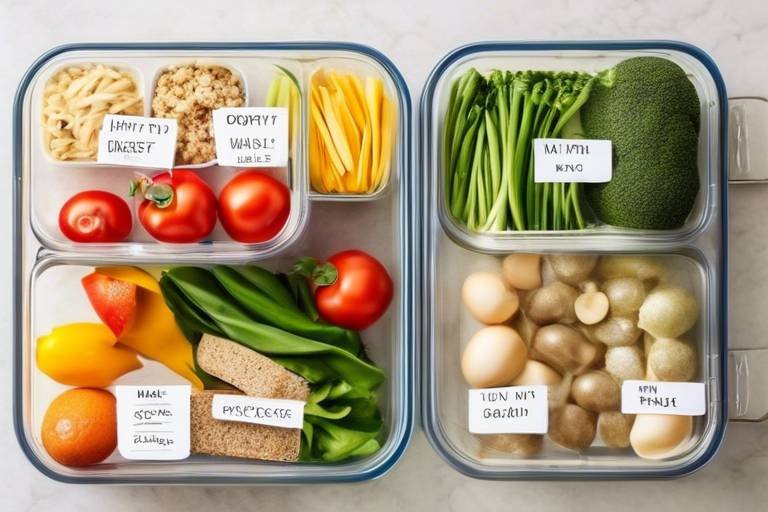Nutrition Tips for Healthy Aging
As we gracefully journey through life, our bodies undergo a myriad of changes, and so do our nutritional needs. It’s not just about adding more candles to the birthday cake; it’s about making informed choices that can enhance our quality of life as we age. You might be wondering, what exactly does “healthy aging” mean? Well, it encompasses maintaining physical health, mental clarity, and emotional well-being, all of which can be significantly influenced by our diet.
Imagine your body as a classic car; it requires the right fuel and regular maintenance to keep it running smoothly. As we age, our metabolism slows down, and we may find ourselves needing fewer calories, but that doesn’t mean we can skimp on essential nutrients. In fact, it’s more important than ever to focus on nutrient-dense foods that provide the vitamins and minerals our bodies need to function optimally. Key nutrients like calcium, vitamin D, fiber, and antioxidants become crucial players in our diet. So, how can we ensure we’re getting these nutrients? Let’s dive into some essential nutrition tips that can help promote healthy aging.
As we age, our nutritional requirements shift. For instance, our bodies may need more calcium and vitamin D to maintain strong bones, while fiber becomes essential for digestive health. It’s like upgrading the parts of our classic car; we need to ensure everything is in tip-top shape. Incorporating a variety of foods into our meals can help meet these changing needs. Think colorful fruits and vegetables, whole grains, lean proteins, and healthy fats. Not only do they taste great, but they also offer a plethora of health benefits.
Staying hydrated is a cornerstone of health, especially for older adults. Did you know that our sense of thirst diminishes as we age? This means we might not feel thirsty even when our bodies need water. Proper hydration can help with everything from maintaining cognitive function to preventing kidney stones. It’s like keeping the oil in that classic car; without it, things can get messy. Aim for at least 8 glasses of water a day, but remember that hydration can also come from foods!
Recognizing the signs of dehydration is essential for prevention. Common symptoms include:
- Dry mouth
- Fatigue
- Dizziness
- Dark urine
If you notice these signs, it’s time to increase your fluid intake. Ignoring dehydration can lead to more serious health issues, so it’s crucial to address it promptly.
Implementing effective hydration strategies can make a significant difference. Here are a few practical tips:
- Keep a water bottle handy.
- Set reminders to drink water throughout the day.
- Incorporate herbal teas or flavored water for variety.
Making hydration a daily priority can help you feel more energized and alert.
Certain foods can contribute to hydration as well. Fruits and vegetables with high water content can be delicious allies in your hydration journey. Consider the following:
| Food | Water Content (%) |
|---|---|
| Watermelon | 92 |
| Cucumber | 95 |
| Strawberries | 91 |
| Celery | 95 |
Incorporating these hydrating foods into your meals can be both refreshing and beneficial.
A balanced diet is critical for healthy aging. Think of it as the foundation of your health. It should include a mix of macronutrients (carbohydrates, proteins, and fats) and micronutrients (vitamins and minerals). Each component plays a vital role in maintaining energy levels and overall vitality. For example, carbohydrates provide energy, proteins support muscle health, and healthy fats are crucial for brain function. So, when planning your meals, aim for a colorful plate that reflects a variety of food groups.
Effective meal planning can simplify healthy eating and ensure that you’re meeting your nutritional needs. It’s like having a roadmap for your health journey. Start by setting aside time each week to plan your meals. Consider your favorite foods and how you can incorporate them into balanced meals. Make a grocery list based on your meal plan to avoid impulse buys and ensure you have all the ingredients you need.
Understanding portion sizes is key to maintaining a healthy weight. It’s easy to overeat, especially with larger serving sizes often found in restaurants. A helpful strategy is to use smaller plates, which can trick your brain into thinking you’re eating more. Additionally, pay attention to hunger cues; eat when you’re hungry and stop when you’re satisfied. This mindful approach to eating can help you enjoy your meals while managing your weight effectively.
Simple cooking tips can enhance the nutritional value of meals. For instance, steaming vegetables preserves their nutrients better than boiling. Incorporate herbs and spices to add flavor without extra calories. Experimenting with different cooking methods can make healthy eating exciting and enjoyable. Remember, cooking at home allows you to control ingredients and portion sizes, making it easier to stick to your nutritional goals.
Q: What are some quick snacks that are healthy for seniors?
A: Great options include nuts, yogurt, fruit, and whole-grain crackers. These snacks are nutrient-dense and easy to prepare.
Q: How can I ensure I'm getting enough protein in my diet?
A: Include sources like lean meats, fish, eggs, dairy, beans, and legumes in your meals. Consider protein shakes if you need an extra boost.
Q: Is it necessary to take supplements as I age?
A: While a balanced diet is ideal, some individuals may benefit from supplements, especially for nutrients like vitamin D and B12. Consult with a healthcare provider to determine what’s best for you.
Q: How can I make healthy eating more enjoyable?
A: Experiment with new recipes, join a cooking class, or cook with friends and family to make healthy eating a fun and social experience.

Understanding Nutritional Needs
As we gracefully age, our bodies undergo various changes that influence our nutritional needs. It's like a car that requires different types of fuel as it ages; our bodies need specific nutrients to keep running smoothly. Key vitamins and minerals become essential for maintaining health, energy, and overall well-being. It's crucial to understand these needs to tailor our diets accordingly.
One of the most important nutrients for older adults is protein. As we age, our muscle mass tends to decrease, a condition known as sarcopenia. Consuming adequate protein helps counteract this loss by supporting muscle repair and growth. Aim for high-quality protein sources such as lean meats, fish, eggs, dairy, legumes, and nuts. Incorporating these into your meals can make a world of difference.
Another vital nutrient is calcium, which is essential for maintaining strong bones. As we age, the risk of osteoporosis increases, making it crucial to consume calcium-rich foods like dairy products, leafy greens, and fortified plant-based milks. Pairing calcium with vitamin D enhances absorption, so consider foods like fatty fish or fortified cereals, and don’t forget to enjoy some sunshine!
Moreover, fiber plays a significant role in digestive health. It helps prevent constipation and supports a healthy gut microbiome. Foods high in fiber include whole grains, fruits, vegetables, and legumes. Not only do they keep our digestive system in check, but they also help manage weight and reduce the risk of chronic diseases.
Let’s not overlook the importance of healthy fats. Omega-3 fatty acids, found in fish, walnuts, and flaxseeds, are excellent for heart health and can even help reduce inflammation. Including a variety of fats in moderation can provide energy and support brain function as we age.
| Nutrient | Benefits | Sources |
|---|---|---|
| Protein | Supports muscle repair and growth | Lean meats, fish, eggs, legumes |
| Calcium | Strengthens bones | Dairy, leafy greens, fortified foods |
| Fiber | Promotes digestive health | Whole grains, fruits, vegetables |
| Healthy Fats | Supports heart and brain health | Fish, nuts, seeds |
It's essential to remember that hydration also plays a critical role in our nutritional needs. As we age, our sense of thirst may diminish, leading to a higher risk of dehydration. Incorporating fluid-rich foods and beverages into your diet can help maintain hydration levels. Think of water-rich fruits like watermelon or cucumbers as your best friends in this journey!
To sum it up, understanding and addressing our nutritional needs as we age is not just about avoiding deficiencies; it’s about enhancing our quality of life. By focusing on a balanced diet rich in protein, calcium, fiber, and healthy fats, we can ensure that our bodies are well-equipped to handle the challenges of aging. So, let’s embrace these changes with open arms and a fork in hand!

Importance of Hydration
This article explores essential nutrition tips that can help promote healthy aging, focusing on dietary choices, nutrient requirements, and lifestyle changes that contribute to overall well-being as we age.
As we age, our nutritional needs change. This section discusses the key nutrients that are vital for seniors and how to incorporate them into daily meals for optimal health.
Staying hydrated is crucial for maintaining health in older adults. As we age, our bodies may lose the ability to sense thirst, leading to an increased risk of dehydration. This is why it's essential to make hydration a priority in our daily routines. Proper hydration supports numerous bodily functions, including digestion, circulation, and temperature regulation, which are vital for overall health. Additionally, it can help prevent common issues such as constipation and urinary tract infections, which can be particularly troublesome for seniors.
Consider this: your body is like a well-oiled machine, and just like any machine, it needs the right amount of fuel to function optimally. Water is that fuel! When you’re well-hydrated, your body operates smoothly, your skin looks healthier, and you even feel more energetic. On the flip side, dehydration can lead to fatigue, confusion, and even more severe health complications. So, how can we ensure we’re getting enough fluids throughout the day? Here are a few tips:
- Carry a water bottle to remind yourself to sip regularly.
- Set reminders on your phone to drink water at regular intervals.
- Incorporate hydrating foods into your meals, which we'll discuss later.
By making hydration a daily habit, you can significantly enhance your quality of life as you age.
Recognizing the signs of dehydration is essential for prevention. Common symptoms include dry mouth, fatigue, dizziness, and dark yellow urine. If you notice any of these signs, it’s crucial to take action immediately. Ignoring these symptoms can lead to more serious health issues, such as kidney stones or urinary tract infections. Remember, staying aware of your body's signals is key to maintaining your health.
Implementing effective hydration strategies can make a significant difference. Here are a few practical tips:
- Start your day with a glass of water to kickstart your hydration.
- Drink a glass of water before each meal.
- Opt for herbal teas or diluted fruit juices if plain water isn’t appealing.
By incorporating these strategies into your daily routine, you can ensure that hydration becomes second nature.
Certain foods can contribute to hydration. Fruits and vegetables with high water content are not only delicious but also a fantastic way to boost your fluid intake. Some excellent options include:
| Food Item | Water Content (%) |
|---|---|
| Watermelon | 92% |
| Cucumber | 95% |
| Strawberries | 91% |
| Celery | 95% |
Incorporating these hydrating foods into your diet not only helps you stay hydrated but also adds essential vitamins and minerals to your meals.
A balanced diet is critical for healthy aging. This section details the components of a nutritious diet, including macronutrients and micronutrients essential for maintaining energy and vitality.
Effective meal planning can simplify healthy eating. This section provides strategies for creating balanced meals that cater to the unique dietary needs of older adults.
Understanding portion sizes is key to maintaining a healthy weight. This subsection discusses how to manage portions effectively while ensuring nutritional adequacy.
Simple cooking tips can enhance the nutritional value of meals. This part offers advice on preparing healthy, flavorful dishes that appeal to seniors and promote longevity.
1. How much water should seniors drink daily?
Most seniors should aim for about 8-10 cups of fluid per day, but individual needs can vary based on activity level and health conditions.
2. What are some signs that I’m not drinking enough water?
Common signs include dry mouth, fatigue, dark urine, and dizziness. If you notice these symptoms, it’s essential to increase your fluid intake.
3. Can I get enough hydration from foods?
Yes! Many fruits and vegetables have high water content and can significantly contribute to your daily hydration needs.
4. Are there any drinks I should avoid?
Limit caffeinated and alcoholic beverages, as they can lead to dehydration.

Signs of Dehydration
As we age, our bodies undergo various changes, and one of the most critical aspects to monitor is hydration. Dehydration can sneak up on anyone, but it can be particularly dangerous for seniors. So, how do you know if you or a loved one is becoming dehydrated? It's essential to recognize the common signs that indicate a lack of adequate fluid intake. These signs can range from mild to severe, and understanding them can help prevent serious health complications.
One of the first signs of dehydration is thirst. If you find yourself feeling thirsty, it’s your body’s way of sending a signal that it needs more fluids. However, many older adults may not feel thirsty until they are already dehydrated, making it crucial to drink water regularly throughout the day, even if you don’t feel thirsty. Additionally, pay attention to the color of your urine; a dark yellow color can indicate dehydration, while light yellow is a sign of proper hydration.
Other signs to watch for include:
- Dry mouth: A lack of moisture can lead to discomfort and difficulty swallowing.
- Fatigue: Feeling unusually tired or lethargic can be a result of not drinking enough water.
- Headaches: Dehydration can often lead to headaches, making it hard to concentrate.
- Dizziness or lightheadedness: When you stand up quickly and feel dizzy, it may be a sign that your body is lacking fluids.
- Confusion or irritability: In more severe cases, dehydration can affect cognitive functions, leading to confusion or mood swings.
It’s essential to take these signs seriously. If you notice any of these symptoms, it’s advisable to increase fluid intake immediately. Ignoring these warning signs can lead to more severe health issues, including kidney problems or urinary tract infections. Remember, prevention is always better than cure, so staying mindful of hydration is key!
In summary, keeping an eye out for the signs of dehydration is vital for maintaining health as we age. Regularly drinking water, monitoring urine color, and being aware of how you feel can help ensure that you stay hydrated and healthy.

Hydration Strategies
Staying hydrated is not just about drinking water; it's about integrating hydration into your daily routine in a way that's enjoyable and sustainable. One effective strategy is to carry a reusable water bottle with you wherever you go. This simple act can serve as a constant reminder to sip throughout the day. You might even consider setting reminders on your phone to take a drink every hour. Think of it as a friendly nudge from your future self, reminding you that hydration is a cornerstone of health.
Another fun way to boost your fluid intake is by infusing your water with fruits and herbs. Imagine sipping on refreshing lemon-mint or cucumber-strawberry water. Not only does it add flavor, but it also makes drinking water feel like a treat rather than a chore. Additionally, incorporating herbal teas into your routine can provide hydration while offering a comforting ritual, especially during cooler months.
It's also essential to pay attention to your meals. Foods with high water content can significantly contribute to your hydration goals. For instance, consider adding the following hydrating foods to your diet:
- Watermelon: This summer favorite is about 92% water!
- Cucumbers: Crisp and refreshing, cucumbers are about 95% water.
- Oranges: Juicy and sweet, oranges are not just delicious but also hydrating.
- Broccoli: This vegetable is around 91% water and packed with nutrients.
Lastly, be mindful of your environment. Hot weather, dry air, and physical activity can all increase your fluid needs. If you find yourself sweating more than usual, it’s crucial to replenish not just with water but also with electrolytes. Consider drinks that contain sodium, potassium, and magnesium, especially after exercise or during hot days. By being proactive about your hydration strategies, you’re setting yourself up for a healthier, more vibrant life as you age.

Hydrating Foods
When it comes to staying hydrated, it’s not just about drinking water; the foods you consume play a crucial role in your overall fluid intake. Many fruits and vegetables are packed with water and can help keep you hydrated while also providing essential nutrients. Think of these hydrating foods as nature's little water bottles, ready to quench your thirst and nourish your body at the same time. For instance, cucumbers, which are about 95% water, can be a refreshing addition to salads or sandwiches. Similarly, watermelon, with its juicy flesh, not only hydrates but also brings a burst of sweetness to your plate.
Incorporating a variety of hydrating foods into your diet can be both delicious and beneficial. Here are some standout options:
- Cucumbers: Crisp and refreshing, they can be enjoyed raw in salads or as snacks.
- Watermelon: A summertime favorite, this fruit is not only hydrating but also rich in vitamins A and C.
- Strawberries: These sweet berries are about 91% water and are a great addition to breakfast or desserts.
- Celery: Low in calories but high in water content, celery sticks make for a crunchy snack.
- Spinach: This leafy green is not only versatile but also contains a significant amount of water, making it perfect for salads or smoothies.
These foods not only help with hydration but also contribute to your overall health by providing vitamins, minerals, and antioxidants. For example, the lycopene in watermelon is known for its heart health benefits, while the fiber in cucumbers aids digestion. So, the next time you’re thinking about how to boost your hydration, consider reaching for these hydrating foods rather than just a glass of water. You can blend them into smoothies, toss them into salads, or simply enjoy them as snacks throughout the day. By making these delicious choices, you're not only satisfying your thirst but also nourishing your body, which is essential for healthy aging.
Remember, hydration is a key component of wellness, especially as we age. Making these hydrating foods a regular part of your meals can help you maintain optimal hydration levels and support your overall health. So, go ahead and fill your plate with these water-rich foods, and let them do their magic!
1. How much water should seniors drink daily?
While the general recommendation is to drink at least 8 cups of water a day, individual needs can vary based on activity level, climate, and health conditions. It's essential to listen to your body and drink when you're thirsty.
2. Can hydrating foods replace drinking water?
Hydrating foods can complement your fluid intake but should not completely replace drinking water. It's important to maintain a balance between both for optimal hydration.
3. What are some easy ways to incorporate hydrating foods into meals?
You can add hydrating foods to smoothies, salads, and salsas, or simply enjoy them as snacks. Experimenting with different recipes can make hydration both fun and tasty!
4. Are there any foods to avoid for hydration?
Foods high in sugar and salt can lead to dehydration, so it's wise to limit processed snacks and sugary drinks. Instead, focus on whole foods that contribute to hydration.

Balanced Diet Essentials
When it comes to healthy aging, a balanced diet is not just important—it's essential! As we grow older, our bodies undergo various changes, influencing our nutritional needs. A well-rounded diet can help maintain energy levels, support immune function, and reduce the risk of chronic diseases. But what exactly constitutes a balanced diet? Let’s break it down into its vital components.
First off, macronutrients play a crucial role in our daily intake. These include carbohydrates, proteins, and fats. Carbohydrates are our body's primary energy source, so including whole grains, fruits, and vegetables is key. Not only do they provide energy, but they also offer essential vitamins and minerals. Next, we have proteins, which are vital for muscle repair and maintenance. Lean meats, fish, eggs, legumes, and dairy products should be staples in your diet. Lastly, healthy fats from sources like avocados, nuts, and olive oil can promote heart health and help with nutrient absorption.
But let’s not forget about micronutrients—the vitamins and minerals that our bodies need in smaller amounts but are just as important. For instance, calcium and vitamin D are essential for maintaining bone health, which becomes increasingly important as we age. Iron is crucial for blood health, while fiber aids in digestion and can help prevent constipation, a common issue among older adults. To ensure you’re getting a variety of these nutrients, aim to include a rainbow of fruits and vegetables in your meals. Each color represents different nutrients, so the more colorful your plate, the better!
Here’s a quick overview of some essential nutrients and their food sources:
| Nutrient | Food Sources |
|---|---|
| Calcium | Dairy products, leafy greens, fortified foods |
| Vitamin D | Fatty fish, fortified milk, sunlight exposure |
| Iron | Red meat, beans, lentils, spinach |
| Fiber | Whole grains, fruits, vegetables, legumes |
In addition to focusing on these nutrients, it's also vital to pay attention to portion sizes. As our metabolism slows down with age, we may not need as many calories as we did in our younger years. However, this doesn't mean we should skimp on nutrition! Instead, focus on nutrient-dense foods that provide more vitamins and minerals per calorie. This approach ensures you're getting the most out of your meals without overindulging.
Lastly, let’s talk about the importance of variety. Eating the same foods day in and day out can lead to nutrient gaps. Try to mix things up! Experiment with new recipes, and incorporate different cuisines to keep your meals exciting and nutritionally balanced. Remember, a balanced diet is not just about what you eat; it’s also about enjoying the process of preparing and consuming food. After all, food is not just fuel; it’s also a source of joy and connection!

Meal Planning for Seniors
Effective meal planning is a game-changer for seniors looking to maintain their health and vitality as they age. It’s not just about what you eat; it’s about how you approach your meals. Think of meal planning as crafting a roadmap for your nutritional journey. By laying out your meals in advance, you can ensure that you’re getting the right balance of nutrients without the stress of last-minute decisions. After all, who wants to scramble for dinner when you can have a delicious, nutritious meal waiting for you?
When planning meals, it's essential to consider the unique dietary needs of older adults. As we age, our metabolism slows down, and our bodies may require fewer calories but more nutrients. This means focusing on nutrient-dense foods that pack a punch without overloading on calories. Incorporating a variety of fruits, vegetables, whole grains, lean proteins, and healthy fats can help meet these requirements. For instance, a colorful plate not only looks appealing but also ensures a range of vitamins and minerals. Aim for a rainbow of colors on your plate!
One effective strategy for meal planning is to create a weekly menu. This doesn’t have to be complicated; it can be as simple as jotting down your meals for the week on a piece of paper or using a meal planning app. Here’s a quick example of how a balanced day might look:
| Meal | Example Foods |
|---|---|
| Breakfast | Oatmeal topped with fresh berries and a sprinkle of nuts |
| Lunch | Grilled chicken salad with mixed greens, cherry tomatoes, and vinaigrette |
| Dinner | Baked salmon with quinoa and steamed broccoli |
| Snacks | Greek yogurt with honey or a piece of fruit |
In addition to planning meals, it’s crucial to pay attention to portion control. As our appetites change, understanding how much food we actually need can help prevent overeating while ensuring we get the necessary nutrients. Using smaller plates can trick the brain into thinking you’re eating more, and measuring out servings can help keep track of portions without the guesswork. Remember, it's not about depriving yourself; it’s about making smarter choices!
Another key aspect of meal planning is preparing meals in advance. Batch cooking can save time and energy, especially on days when you might not feel like cooking. Consider dedicating a day each week to prepare several meals at once. You can store them in the fridge or freezer for easy access later. This not only simplifies your week but also encourages healthier eating habits, as you’ll be less tempted to reach for unhealthy convenience foods.
Lastly, don’t forget to involve social aspects in your meal planning. Eating is often a communal activity, and sharing meals with family or friends can enhance the experience. Organizing a potluck or inviting loved ones over for dinner can make healthy eating feel less like a chore and more like a celebration. After all, food is meant to be enjoyed!
- How can I ensure I'm getting enough nutrients? Focus on a variety of foods that include fruits, vegetables, whole grains, and lean proteins. Consulting a dietitian can also help tailor a plan to your specific needs.
- What are some easy meal prep ideas? Consider preparing soups, stews, or casseroles that can be easily reheated. Also, pre-chopping vegetables can save time during the week.
- How can I make meal planning more enjoyable? Try new recipes, involve friends or family in the cooking process, and make it a fun activity rather than a chore!

Portion Control
Understanding is essential for maintaining a healthy weight and ensuring that we get the right amount of nutrients as we age. As our metabolism slows down, our bodies require fewer calories, but that doesn't mean we should skimp on nutrition. In fact, it’s quite the opposite! We need to focus on nutrient-dense foods that provide the vitamins and minerals our bodies need to thrive.
One effective way to manage portion sizes is to use smaller plates and bowls. This simple trick can create the illusion of a fuller plate, helping to satisfy our visual hunger. When we see a full plate, our brains often signal that we are ready to eat, even if the portion is smaller. Additionally, measuring out servings can be a game changer. For example, using measuring cups or a food scale can help you understand what a proper portion looks like, especially for foods that are calorie-dense, like nuts and oils.
Another helpful strategy is to fill half your plate with vegetables. Not only are vegetables low in calories, but they are also packed with fiber, which can help you feel fuller for longer. Think of your plate as a colorful canvas where you can create a masterpiece of health! Aim for a variety of colors, as different hues often represent different nutrients. For instance, leafy greens like spinach are rich in iron, while orange carrots are loaded with beta-carotene.
It’s also important to listen to your body’s hunger cues. Are you eating because you’re genuinely hungry, or is it out of habit or boredom? Practicing mindful eating can help you become more aware of your body’s signals. Try to eat slowly, savoring each bite, and put your fork down between bites. This practice not only enhances your enjoyment of food but also gives your brain time to register fullness, which can prevent overeating.
Here’s a quick reference table to illustrate suggested portion sizes for common food groups:
| Food Group | Recommended Portion Size |
|---|---|
| Fruits | 1 medium piece or 1/2 cup chopped |
| Vegetables | 1 cup raw or 1/2 cup cooked |
| Grains | 1/2 cup cooked or 1 slice of bread |
| Protein | 3-4 ounces (about the size of a deck of cards) |
| Dairy | 1 cup of milk or yogurt, or 1.5 ounces of cheese |
In conclusion, mastering portion control is a valuable skill that can lead to healthier eating habits and improved well-being as we age. By being mindful of our portion sizes, we can enjoy a variety of foods while still meeting our nutritional needs. Remember, it’s not just about what you eat, but how much you eat that makes a significant difference in your health journey!
- What is the best way to measure portion sizes? Using measuring cups, a food scale, or even visual cues can help you gauge appropriate portion sizes.
- How can I practice mindful eating? Focus on eating slowly, savoring each bite, and paying attention to your body’s hunger cues.
- Are there any specific foods I should avoid for portion control? Foods high in sugar and fat can be easy to overeat. It’s best to enjoy them in moderation.

Cooking Tips
This article explores essential nutrition tips that can help promote healthy aging, focusing on dietary choices, nutrient requirements, and lifestyle changes that contribute to overall well-being as we age.
As we age, our nutritional needs change. This section discusses the key nutrients that are vital for seniors and how to incorporate them into daily meals for optimal health.
Staying hydrated is crucial for maintaining health in older adults. This section explores the benefits of proper hydration and tips for ensuring adequate fluid intake throughout the day.
Recognizing the signs of dehydration is essential for prevention. This subsection outlines common symptoms and the importance of addressing them promptly to avoid health complications.
Implementing effective hydration strategies can make a significant difference. This part provides practical tips for increasing fluid intake and making hydration a daily priority.
Certain foods can contribute to hydration. This section highlights fruits and vegetables that are high in water content, offering delicious ways to stay hydrated.
A balanced diet is critical for healthy aging. This section details the components of a nutritious diet, including macronutrients and micronutrients essential for maintaining energy and vitality.
Effective meal planning can simplify healthy eating. This section provides strategies for creating balanced meals that cater to the unique dietary needs of older adults.
Understanding portion sizes is key to maintaining a healthy weight. This subsection discusses how to manage portions effectively while ensuring nutritional adequacy.
Cooking for health doesn't have to be a chore; in fact, it can be quite enjoyable! The way you prepare your meals can greatly influence their nutritional value and overall appeal. Start by incorporating a variety of colorful fruits and vegetables into your dishes, as they are packed with essential vitamins and minerals. Think of your plate as a canvas—each color represents different nutrients that your body craves.
Another important tip is to opt for healthier cooking methods. Instead of frying, try steaming, baking, or grilling your food. These methods not only preserve the nutrients but also reduce the amount of unhealthy fats in your meals. For instance, grilling vegetables can enhance their natural sweetness while keeping them crunchy and delicious.
Don't forget about seasoning! Herbs and spices can elevate the flavor of your meals without adding extra salt or sugar. Experiment with fresh herbs like basil, parsley, or cilantro to give your dishes a fresh twist. This way, you can enjoy flavorful meals that are also heart-healthy.
When it comes to cooking grains, consider whole grains like quinoa, brown rice, and whole wheat pasta. These options are not only more nutritious but also provide a satisfying texture that can make your meals more enjoyable. You can even try mixing different grains together for a delightful medley of flavors.
Lastly, make it a habit to cook in batches. Preparing larger quantities allows you to have healthy meals ready for the week, saving you time and ensuring you stick to your nutritional goals. Storing meals in portion-sized containers can make it easier to grab a healthy option on busy days.
Q: What are some easy meals to prepare for seniors?
A: Simple meals like vegetable stir-fry, oatmeal with fruits, and grilled chicken with steamed veggies are nutritious and easy to prepare.
Q: How can I ensure my meals are balanced?
A: Aim to include a source of protein, healthy fats, and a variety of fruits and vegetables in each meal.
Q: Is it necessary to take supplements as I age?
A: While a balanced diet is ideal, some seniors may benefit from supplements. It's best to consult with a healthcare professional.
Frequently Asked Questions
- What are the key nutrients seniors need for healthy aging?
As we age, our bodies require essential nutrients to maintain health. Key nutrients include protein for muscle maintenance, calcium and vitamin D for bone health, fiber for digestive health, and antioxidants to combat oxidative stress. Incorporating these nutrients into daily meals can significantly enhance overall well-being.
- How can I ensure I'm staying hydrated as I age?
Staying hydrated is vital for seniors, as thirst sensation diminishes with age. Aim to drink water regularly throughout the day, and consider hydrating foods like fruits and vegetables. Setting reminders or using a water bottle can help keep fluid intake top of mind.
- What are the signs of dehydration I should look out for?
Common signs of dehydration include dry mouth, fatigue, dizziness, and dark urine. If you notice these symptoms, it's essential to increase your fluid intake immediately to prevent further complications.
- What are some effective hydration strategies?
To boost hydration, try carrying a water bottle with you, drinking a glass of water before meals, and incorporating soups and broths into your diet. Additionally, setting daily water goals can help you stay on track.
- What foods can help with hydration?
Certain fruits and vegetables have high water content and can aid in hydration. Examples include cucumbers, watermelon, oranges, and strawberries. These not only keep you hydrated but also provide essential vitamins and minerals.
- How can I plan balanced meals for seniors?
Effective meal planning involves incorporating a variety of food groups. Focus on whole grains, lean proteins, healthy fats, fruits, and vegetables. Preparing meals in advance can also help ensure that nutritious options are readily available.
- What is the importance of portion control for seniors?
Understanding portion sizes is crucial for maintaining a healthy weight and preventing overeating. Using smaller plates, measuring servings, and being mindful of hunger cues can help manage portions effectively.
- What cooking tips can enhance the nutritional value of meals?
Simple cooking techniques like steaming, grilling, or roasting can preserve nutrients. Additionally, using herbs and spices instead of salt can enhance flavor without compromising health. Experimenting with different cooking methods can make meals more appealing and nutritious.

